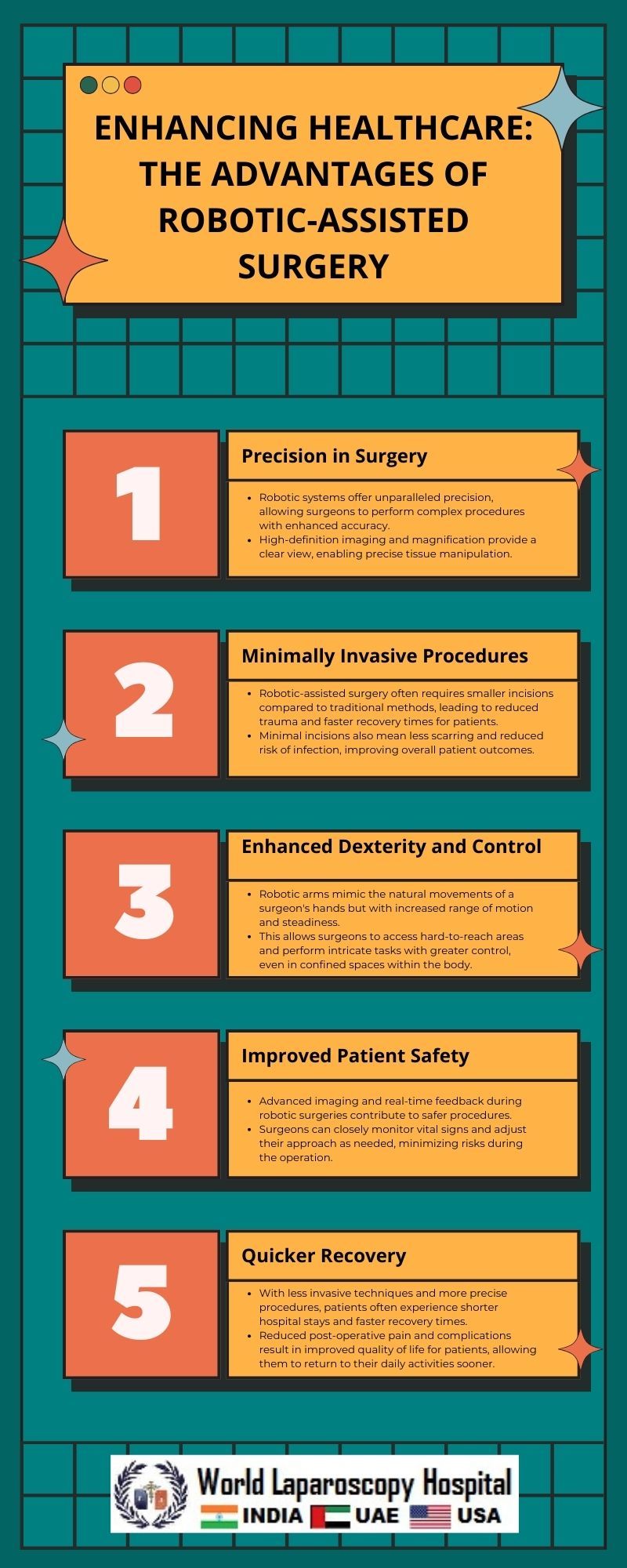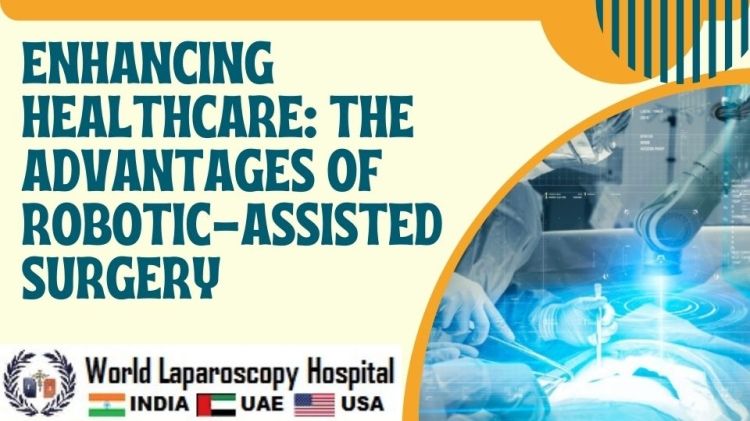Enhancing Healthcare: The Advantages of Robotic-Assisted Surgery
Introduction:
In recent years, the field of healthcare has witnessed remarkable advancements in surgical techniques, particularly with the introduction of robotic-assisted surgery. This innovative approach combines the expertise of surgeons with cutting-edge robotic technology to perform intricate procedures with unparalleled precision. As the popularity of robotic-assisted surgery continues to grow, it is imperative to delve into its advantages and implications for healthcare. This article explores the transformative impact of robotic-assisted surgery, highlighting its numerous advantages and discussing its role in shaping the future of healthcare.

Understanding Robotic-Assisted Surgery:
Robotic-assisted surgery involves the use of robotic systems to aid surgeons in performing various medical procedures. These systems are equipped with advanced instruments and cameras that provide high-definition, three-dimensional visualization of the surgical site. Surgeons control the robotic arms through a console, manipulating the instruments with precision and dexterity. This technology allows for minimally invasive procedures, where small incisions are made, reducing trauma to the patient's body and promoting faster recovery times.
Advantages of Robotic-Assisted Surgery:
Precision and Accuracy:One of the most significant advantages of robotic-assisted surgery is its exceptional precision and accuracy. The robotic system translates the surgeon's movements into precise actions, minimizing the risk of human error. This level of precision is particularly crucial in delicate procedures such as cardiac surgery, where even slight deviations can have profound consequences. By enhancing accuracy, robotic-assisted surgery improves patient safety and reduces the likelihood of complications.
Enhanced Visualization:Robotic systems provide surgeons with enhanced visualization of the surgical site, surpassing what is achievable with traditional techniques. High-definition cameras deliver clear, magnified images in three dimensions, allowing surgeons to navigate complex anatomical structures with ease. This improved visualization enables more thorough exploration of the surgical area, leading to better outcomes and reduced risks of inadvertent damage to surrounding tissues.
Minimally Invasive Approach:Robotic-assisted surgery facilitates a minimally invasive approach to various procedures, offering numerous benefits for patients. Unlike traditional open surgery, which requires large incisions, robotic procedures involve small, precise incisions. This minimizes trauma to the body, reduces postoperative pain, and accelerates recovery times. Patients undergoing robotic-assisted surgery typically experience shorter hospital stays and quicker return to normal activities, enhancing their overall quality of life.
Surgeon Ergonomics and Comfort:Operating with traditional surgical techniques can be physically demanding for surgeons, often leading to fatigue and discomfort over extended procedures. Robotic-assisted surgery addresses this challenge by offering improved ergonomics and comfort for surgeons. Operating consoles are designed to accommodate ergonomic positioning, reducing strain on the surgeon's body. This allows for prolonged periods of precise manipulation without compromising accuracy or performance, ultimately benefiting both the surgeon and the patient.
Complex Procedures Made Accessible:Robotic-assisted surgery expands the realm of possibilities for complex surgical procedures that may have been considered too challenging or risky with traditional techniques. The enhanced precision and maneuverability of robotic systems enable surgeons to tackle intricate surgeries with greater confidence and success rates. This includes procedures in various specialties such as urology, gynecology, oncology, and thoracic surgery. As a result, patients have access to advanced treatments that offer improved outcomes and better long-term prognosis.
Reduced Blood Loss and Transfusion Rates:Another notable advantage of robotic-assisted surgery is the reduction in blood loss and transfusion rates compared to traditional approaches. The precise control provided by robotic systems allows surgeons to minimize trauma to blood vessels, resulting in less intraoperative bleeding. This is particularly beneficial for patients with underlying medical conditions or those undergoing extensive procedures where blood loss can pose significant risks. By reducing the need for transfusions, robotic-assisted surgery promotes safer surgeries and faster recovery.
Faster Recovery and Shorter Hospital Stays:Patients undergoing robotic-assisted surgery often experience faster recovery times and shorter hospital stays compared to traditional surgery. The minimally invasive nature of robotic procedures contributes to quicker postoperative healing, allowing patients to resume their daily activities sooner. Additionally, the reduced risk of complications and lower rates of postoperative pain contribute to a more comfortable recovery experience. Shorter hospital stays also translate to cost savings for healthcare systems, making robotic-assisted surgery an economically viable option in the long run.
Improved Cosmetic Outcomes:In addition to its clinical benefits, robotic-assisted surgery can also lead to improved cosmetic outcomes for patients. The smaller incisions used in robotic procedures result in minimal scarring compared to traditional open surgery. This is particularly significant for patients undergoing procedures in visible areas such as the face or abdomen. By preserving aesthetic integrity, robotic-assisted surgery enhances patient satisfaction and confidence in their appearance postoperatively.
Implications for Healthcare:
The widespread adoption of robotic-assisted surgery has profound implications for the future of healthcare. As technology continues to evolve, robotic systems are becoming increasingly sophisticated, offering enhanced capabilities and expanding the range of procedures that can be performed robotically. This trend is reshaping surgical practices across various specialties, with robotic-assisted surgery becoming the standard of care for many complex procedures.
Furthermore, the integration of artificial intelligence (AI) and machine learning algorithms into robotic systems holds the promise of further improving surgical outcomes. AI-driven assistance can provide real-time feedback to surgeons, offering insights into optimal surgical techniques and enhancing decision-making during procedures. This synergy between human expertise and technological innovation has the potential to revolutionize surgical care, ushering in a new era of precision medicine.
However, despite its numerous advantages, the widespread adoption of robotic-assisted surgery also presents challenges and considerations for healthcare providers. These include the initial cost of acquiring and maintaining robotic systems, the need for specialized training for surgeons and operating room staff, and concerns regarding patient access and equity. Addressing these challenges will be essential to ensure that robotic-assisted surgery remains accessible and beneficial for patients across diverse healthcare settings.
Conclusion:
Robotic-assisted surgery represents a paradigm shift in surgical care, offering unparalleled precision, enhanced outcomes, and improved patient experiences. Its advantages extend across various specialties, making complex procedures more accessible and safer for patients. As technology continues to advance and robotic systems become more sophisticated, the future of healthcare holds exciting possibilities for further innovation and refinement in surgical practices. By embracing robotic-assisted surgery, healthcare providers can continue to elevate the standard of care and improve the lives of patients around the world.
